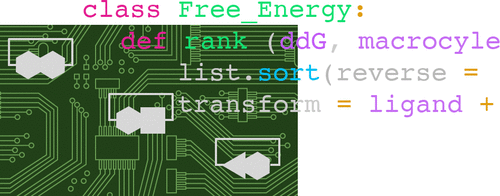当前位置:
X-MOL 学术
›
J. Chem. Inf. Model.
›
论文详情
Our official English website, www.x-mol.net, welcomes your
feedback! (Note: you will need to create a separate account there.)
Evaluation of Free Energy Calculations for the Prioritization of Macrocycle Synthesis.
Journal of Chemical Information and Modeling ( IF 5.6 ) Pub Date : 2020-06-15 , DOI: 10.1021/acs.jcim.0c00132 Janet L Paulsen 1 , Haoyu S Yu 1 , Dan Sindhikara 1 , Lingle Wang 1 , Todd Appleby 2 , Armando G Villaseñor 2 , Uli Schmitz 2 , Devleena Shivakumar 2
Journal of Chemical Information and Modeling ( IF 5.6 ) Pub Date : 2020-06-15 , DOI: 10.1021/acs.jcim.0c00132 Janet L Paulsen 1 , Haoyu S Yu 1 , Dan Sindhikara 1 , Lingle Wang 1 , Todd Appleby 2 , Armando G Villaseñor 2 , Uli Schmitz 2 , Devleena Shivakumar 2
Affiliation

|
A tremendous research and development effort was exerted toward combating chronic hepatitis C, ultimately leading to curative oral treatments, all of which are targeting viral proteins. Despite the advantage of numerous targets allowing for broad hepatitis C virus (HCV) genotype coverage, the only host target inhibitors that advanced into clinical development were Cyclosporin A based cyclophilin inhibitors. While cyclosporin-based molecules typically require a fermentation process, Gilead successfully pursued a fully synthetic, oral program based on Sanglifehrin A. The drug discovery process, though greatly helped by facile crystallography, was still hampered by the limitations in the accuracy of predictive computational methods for prioritizing compound ideas. Recent advances in accuracy and speed of free energy perturbation (FEP) methods, however, are attractive for prioritizing and derisking synthetically challenging molecules and potentially could have had a significant impact on the speed of the development of this program. Here in our simulated prospective study, the binding free energies of 26 macrocyclic cyclophilin inhibitors were blindly predicted using FEP+ to test this hypothesis. The predictions had a low mean unsigned error (MUE) (1.1 kcal/mol) and accurately reproduced many design decisions from the program, suggesting that FEP+ has the potential to drive synthetic chemistry efforts by more accurately ranking compounds with nonintuitive structure–activity relationships (SARs).
中文翻译:

评估大环合成优先级的自由能计算。
为了对抗慢性丙型肝炎,人们进行了巨大的研究和开发工作,最终导致了治疗性口服治疗,所有这些治疗均针对病毒蛋白。尽管众多靶标具有广泛的丙型肝炎病毒(HCV)基因型覆盖率的优势,但进入临床开发的唯一宿主靶标抑制剂是基于环孢菌素A的亲环蛋白抑制剂。尽管基于环孢菌素的分子通常需要发酵过程,但吉利德成功地进行了基于桑弗利林A的完全合成的口服程序。药物发现过程尽管得到了容易的晶体学的极大帮助,但仍受预测计算方法准确性限制的困扰优先考虑复合想法。自由能摄动(FEP)方法的准确性和速度方面的最新进展,但是,它对于区分具有挑战性的合成挑战分子的优先级和降低风险具有吸引力,并且可能会对该程序的开发速度产生重大影响。在我们的模拟前瞻性研究中,使用FEP +盲目预测了26种大环亲环蛋白抑制剂的结合自由能,以验证这一假设。这些预测的平均无符号误差(MUE)低(1.1 kcal / mol),并且可以从程序中准确再现许多设计决策,这表明FEP +有潜力通过更准确地对具有非直觉结构-活性关系的化合物进行排名来推动合成化学的努力( SARs)。在我们的模拟前瞻性研究中,使用FEP +盲目预测了26种大环亲环蛋白抑制剂的结合自由能,以验证这一假设。这些预测的平均无符号误差(MUE)低(1.1 kcal / mol),并且可以从程序中准确再现许多设计决策,这表明FEP +有潜力通过更准确地对具有非直觉结构-活性关系的化合物进行排名来推动合成化学的努力( SARs)。在我们的模拟前瞻性研究中,使用FEP +盲目预测了26种大环亲环蛋白抑制剂的结合自由能,以验证这一假设。这些预测的平均无符号误差(MUE)低(1.1 kcal / mol),并且可以从程序中准确再现许多设计决策,这表明FEP +有潜力通过更准确地对具有非直觉结构-活性关系的化合物进行排名来推动合成化学的努力( SARs)。
更新日期:2020-07-27
中文翻译:

评估大环合成优先级的自由能计算。
为了对抗慢性丙型肝炎,人们进行了巨大的研究和开发工作,最终导致了治疗性口服治疗,所有这些治疗均针对病毒蛋白。尽管众多靶标具有广泛的丙型肝炎病毒(HCV)基因型覆盖率的优势,但进入临床开发的唯一宿主靶标抑制剂是基于环孢菌素A的亲环蛋白抑制剂。尽管基于环孢菌素的分子通常需要发酵过程,但吉利德成功地进行了基于桑弗利林A的完全合成的口服程序。药物发现过程尽管得到了容易的晶体学的极大帮助,但仍受预测计算方法准确性限制的困扰优先考虑复合想法。自由能摄动(FEP)方法的准确性和速度方面的最新进展,但是,它对于区分具有挑战性的合成挑战分子的优先级和降低风险具有吸引力,并且可能会对该程序的开发速度产生重大影响。在我们的模拟前瞻性研究中,使用FEP +盲目预测了26种大环亲环蛋白抑制剂的结合自由能,以验证这一假设。这些预测的平均无符号误差(MUE)低(1.1 kcal / mol),并且可以从程序中准确再现许多设计决策,这表明FEP +有潜力通过更准确地对具有非直觉结构-活性关系的化合物进行排名来推动合成化学的努力( SARs)。在我们的模拟前瞻性研究中,使用FEP +盲目预测了26种大环亲环蛋白抑制剂的结合自由能,以验证这一假设。这些预测的平均无符号误差(MUE)低(1.1 kcal / mol),并且可以从程序中准确再现许多设计决策,这表明FEP +有潜力通过更准确地对具有非直觉结构-活性关系的化合物进行排名来推动合成化学的努力( SARs)。在我们的模拟前瞻性研究中,使用FEP +盲目预测了26种大环亲环蛋白抑制剂的结合自由能,以验证这一假设。这些预测的平均无符号误差(MUE)低(1.1 kcal / mol),并且可以从程序中准确再现许多设计决策,这表明FEP +有潜力通过更准确地对具有非直觉结构-活性关系的化合物进行排名来推动合成化学的努力( SARs)。











































 京公网安备 11010802027423号
京公网安备 11010802027423号